This website uses cookies to improve your browsing experience and analyze the use of the website. Learn More

Reserve Your Spot with Confidence! Full Refunds with 24 Hrs Notice. Reschedule at any point, even after tour, if space allows!
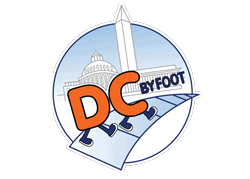
How to Tour the Supreme Court

This post covers how to attend a U.S. Supreme Court tour as well as courtroom lectures and oral arguments with tips on how to plan your visit and what you might see.
- Where is the Supreme Court
- Guided Tours + Exhibits
- Courtroom Lecture
- Attend a Supreme Court Case
- Visit the US Capitol and Library of Congress
- Other Things to Do in DC
HOW TO GET TO THE SUPREME COURT
The Supreme Court Building is located at 1 First Street St NE across the street from the US Capitol Building and the Library of Congress.
Use this link for directions to the Supreme Court .
Or let us take you here on one of our pay-what-you-like Capitol Hill Tours .
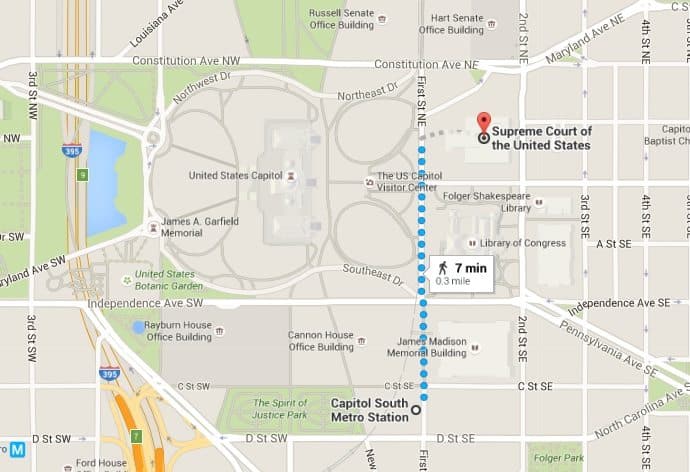
It is a 7 min walk from the Capitol South Station Metro ( Blue , Orange , Silver ). Exit the station and continue north on First Street for two blocks.
It is also about a 15-minute walk from Union Station ( Red ), which has a paid parking garage.
If you are new to DC's subway system, then read our guide on how to use the DC Metro system .
There are no parking facilities at the building. Street parking is very limited. You can reserve a space at nearby commercial garages through a service called SpotHero .
Supreme Court Hours:
The Supreme Court is open on weekdays 9 am - 3 pm , excluding Federal Holidays. The building is not open on the weekend.
Like most federal buildings, you will be required to enter through security. There are two doors on either side of the main steps on the plaza level to enter the building.
Prohibited items include weapons and other dangerous items.

SUPREME COURT TOURS + CURRENT EXHIBITS
The Supreme Court currently does not offer guided tours; visitors are encouraged to tour the building independently ( or on a tour with us !).
In reality, visitors are limited to only the public portions of the building, which are mostly the exhibits on the ground floor as well as the Main Hall on the 2nd floor.
There are several opportunities to visit the main courtroom (see below sections on attending a court lecture or to hear a case ).
Once through security, you will be on the ground floor.
Here you will find a 24-minute film that covers the history of the building, with interviews with the Chief Justice as well as Associate and former Justices.
It's on this floor where you will also find the current exhibitions .
- The Supreme Court Building: America's Temple of Justice
- Reading the Law: Legal Education in America
- Sandra Day O'Connor, First Woman on the Supreme Court
- The Power of Image: Charles Evans Hughes in Prints, Photographs, and Drawings
- Capturing Justice: Judicial Portraits by Augustus Saint-Gaudens
Supreme Court Building Tours
We are able to offer small group private tours that visit inside the Supreme Court on private versions of our Capitol Hill & Library of Congress Tour!
This 2 hour tour would tour inside the Supreme Court Building, inside the Library of Congress & end with tickets to tour inside the Capitol Building with their professional docents (this tour would be an additional 50 minutes to our 2 hour tour)
Our almost twice-a-day public version of this tour does not guarantee entrance into the Supreme Court (though sometimes we can visit inside based on security and opening). On private tours, we can schedule it to ensure we can go inside the Supreme Court.
Contact us to book a private Capitol Hill tour that enters the Supreme Court!
HOW TO ATTEND A SUPREME COURT LECTURE
Since this is a working federal building, you are limited as to where you can go on your self-guided tour.
The only way to visit the courtroom is by attending a docent lecture or attending a case.

You can read about attending a case below but if you are visiting on a day that the court is not hearing a case, you can still have a seat in the courtroom and listen to the history of the court and the building.
30-minute courtroom lectures are held every half-hour from 9:30 am to 3:30 pm.
Seating is first-come, first-served, so during the busy spring and summer months, expect to get there early to wait in line.
For the most up-to-date information on when lectures are scheduled, visit the lecture calendar .
HOW TO ATTEND A SUPREME COURT ORAL ARGUMENT
While you can visit the Supreme Court courtroom as a visitor for lectures, cases are also open to the public.
Called Oral Arguments, these are the 1-hour long sessions where each side is allowed 30 minutes to argue before the court.
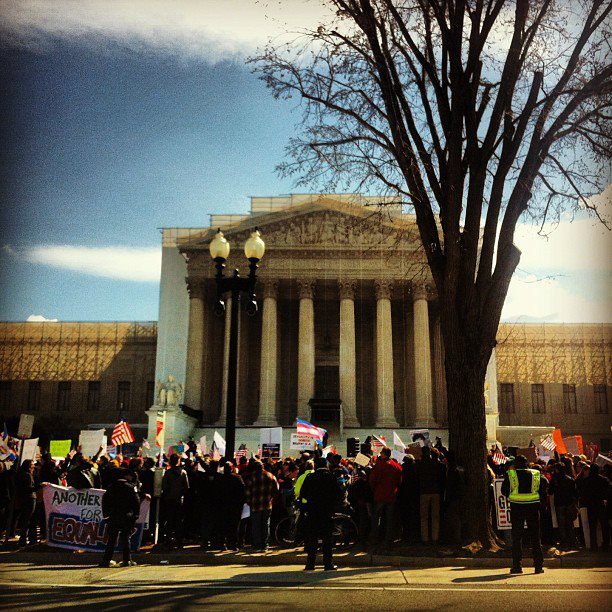
From the first Monday to October to Mid-April, cases are generally heard on Mondays, Tuesdays, and Wednesdays at 10 am and at 11 am, with additional afternoon sessions as needed.
There are two ways to attend a Supreme Court case.
You could either secure a seat and witness the entire Oral Arguments, or you can catch a quick 3-minute glimpse of the proceedings. (the 3-minute line is suspended still as of Feb 2024)
These two lines form on the plaza before each case.
For a landmark Supreme Court case, some people will line up days in advance to guarantee a spot. On a non-high-profile day, people arrive around 6 am-7 am.
Normally, only the first 50 are able to get in for the entire session.
Numbered tickets are given out prior to seating to allow you time to go to the restroom, cafeteria, and cloakroom.
If you don't get a seat , you can also do a walk-through where you stay for a few minutes and then move on. You can rotate through as many times as you'd like by getting back in line. (This is not an option as of Feb 2024. We hope it returns soon!)
You can also attend Bench Mondays (Mondays, 10 am, mid-May through June) to hear the court opinions and decisions.
These are about 15 - 30 minutes long, but can also form long lines for high-profile cases.
To see what cases are being argued, visit the Argument Calendar.
SUPREME COURT JUSTICES
How many justices are on the Supreme Court?
There are 9 Supreme Court Justices in total: 8 associate justices and one Chief Justice.
How do you become a Supreme Court Justice?
There are only two requirements to be a Supreme Court justice. It is not based on age, citizenship, or experience.
You must be nominated by the President and approved by Senate. It is a lifetime appointment that one holds until they retire.
Who is the Chief Justice of the Supreme Court?
The Supreme Court Chief Justice is a position appointed by the President, so it is not relevant to the length of time they serve on the court.
The current Supreme Court Justice is John Roberts.

Who are the current Supreme Court Justices?
- Clarence Thomas (1991)
- John Roberts (2005
- Samuel Alito (2006)
- Sonia Sotomeyer (2009)
- Elena Kagen (2010)
- Neil Gorsuch (2017)
- Brett Cavanaugh (2018)
- Amy Coney Barrett (2020)
- Ketanji Brown Jackson (2022)
VISIT THE U.S. CAPITOL BUILDING AND THE LIBRARY OF CONGRESS
Why not make a half-day of it and visit both the U.S. Capitol Building as well as the Thomas Jefferson Building of the Library of Congress?
Both are adjacent to the Supreme Court Building.
You could also have lunch at the Capitol Visitor Center.
For more information on visiting and touring both buildings, click on the links below.
- U.S. Capitol Building
- Library of Congress

Choose a Destination... I want them all PLUS general travel tips. Amsterdam Berlin Boston Charleston Chicago Dubai Lisbon London Los Angeles Miami Nashville New York City New Orleans Paris Philadelphia Prague Rome San Francisco Washington DC
About The Author

Canden Arciniega
North america, united kingdom & ireland, middle east & india, asia & oceania.

- San Antonio
- St. Augustine
- Washington DC
- Home Main nav menu item
- MAP & STOPS Main nav menu item
- Things to DO Main nav menu item
- SCHEDULE Main nav menu item
- FAQS Main nav menu item
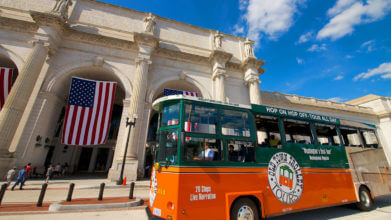
☆☆☆☆☆
★★★★★
789 reviews
Old Town Trolley Tours Washington DC 4.2
U.S. Supreme Court
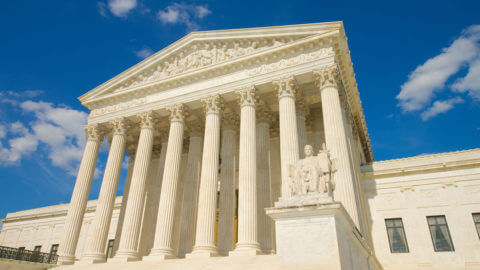
Upon arrival at the Supreme Court, visitors are often struck by the imposing marble building. Architecturally magnificent, the neoclassical structure was built in 1935 to become the permanent home to the Supreme Court. Walking along the hallway towards the Courtroom, guests are greeted by busts of all the former Chief Justices. The Supreme Court is the highest judiciary authority in the United States and hears about 100 cases each year, although more than 7,000 are submitted before them. Visitors can tour the Supreme Court building, hear lectures on the history of the court and how it works, sit in on sessions on specified days and times and view various exhibits throughout the year.
Despite its central role as one of the three main branches of government outlined in the U.S. Constitution, the Supreme Court did not have its own venue to conduct business for the first 145 years of its existence. The Court initially met in the Merchants Exchange Building while the capital was located in New York. When the nation’s capital moved to Philadelphia beginning in 1790, the Court met in Independence Hall and City Hall. With the establishment of the federal city 10 years later, the Supreme Court occupied chambers in various parts of the Capitol Building. It would also convene in a private residence for a short time after British soldiers burned Washington, D.C. during the War of 1812. The Court would return to the Capitol and occupy the Old Supreme Court Chamber from 1819 until 1860. With expansion of the Capitol, the Court was relocated and convened in the Old Senate Chamber from 1860 until 1935.
Brief History of the Supreme Court Building
Former president and then Chief Justice of the Supreme Court, William Howard Taft persuaded Congress in 1929 to authorize the construction of a separate building for the Court. Architect Cass Gilbert was selected to design the new federal building. The construction project began in 1932. Neither Taft nor Gilbert survived to see the completed building, which was finished in 1935. Chief Justice Charles Hughes and Cass Gilbert, Jr. oversaw the construction of the new Courthouse, which was completed under budget.
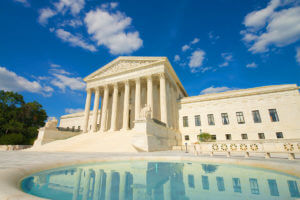
The Supreme Court Building occupies a site that was once the setting of the Old Brick Capitol, which served as a temporary capitol from 1815 until 1819. The building was also a private school boarding house and prison. It was razed in 1929 to make room for the new Supreme Court Building. A basketball court on the building’s fifth floor is colloquially known as “the highest court in the land.” The Supreme Court Building is one of only a few buildings designated as a National Landmark that is not listed on the National Register of Historic Places .
Must See Exhibits
The Supreme Court Building does not offer guided tours. You are encouraged to view the public spaces at your own pace. The exterior grounds as well as portions of the ground and first floors are open to the public. The building’s main façade faces west toward the U.S. Capitol . The main plaza includes fountains, flagpoles and benches as well as marble candelabra depicting “Justice” holding a sword and scales. A bas-relief sculpture of the Greek deities known as the Three Fates knit the thread of life. The base of each flagpole contains symbolic designs of scales, a sword, pen and book as well as the elements of earth, air, water and fire.
Two sculptures of seated figures by James Earle Fraser flank the main entrance. While the female figure entitled Contemplation of Justice is situated on the left, the male figure Guardian of Authority is found on the right. The 6.5-ton bronze doors depict historic scenes from the development of law created by John Donnelly, Jr. Above the entrance is the inscription “Equal Justice Under Law.” On the east side of the building, there are several sculptures of famous lawgivers by Hermon MacNeil. These include Confucius, Moses and Solomon. The east façade bears the inscription “Justice, the Guardian of Liberty.”
Inside the building, visitors can tour the Great Hall. It features busts of former chief justices and friezes depicting heraldic devices and profiles of famous lawgivers. The most famous is the 1883 bust depiction of John Marshall by William Wetmore Story. It stood on the west lawn of the Capitol until it was relocated in 1981. You can also see two five-story self-supporting bronze and marble staircases. The Court Chamber features 24 imported Italian marble columns as well as sculpted marble panels of famous lawgivers and legal themes.
Seating during oral arguments and other proceedings in the courtroom are available to a limited number of guests on a first-come, first-served basis. Various lectures, films and court-related exhibits are offered throughout the day. Docents present lectures about the courtroom that last approximately 30 minutes. The lectures start at the bottom of the hour when the court is not in session.
Know Before You Go
The Supreme Court Building is open Monday through Friday from 9 a.m. until 4:30 p.m. with the exception of federal holidays. It is closed Saturdays and Sundays. Portions of the building may be cordoned off when Court is in session. Visitors pass through security and enter the building from the plaza located beside the main steps. Admission is free of charge. The largest crowds gather from March through June . Because the building contains working offices, visitors are asked to tour as quietly as possible. Video and still photography are prohibited. Eating and drinking are only allowed in the cafeteria. The closest Metro stops are Capitol South on the Orange, Blue and Silver lines and Union Station on the Red line
Attractions Nearby
Library of Congress
Featured in scenes of the film “National Treasure: Book of Secrets,” the Library of Congress is the oldest cultural institution in America. You can take a one-hour docent-led guided tour of the Thomas Jefferson Building to learn about the building’s art and architecture. The narration also includes information about the Library’s history and collection as well.
U.S. Capitol
A symbol of American democracy across the globe, the U.S. Capitol is among the most architecturally impressive buildings in the country. During public tours, visitors can learn about its history as well as view the Rotunda and the Crypt along with sculptures, paintings and other works of art.
Upper and Lower Senate Park
Adjacent to the north portico of the Capitol, Upper and Lower Senate Parks feature landscaped gardens, a reflecting pool and fountains. You can enjoy shade tree-lined pathways, memorials and the historic Summerhouse.
DC Old Town Trolley Tour
Old Town Trolley is a convenient way to explore the Supreme Court while maximizing your vacation time. Upon this lofty perch sits the iconic marble facade where the most important legal decisions in the United States are made. Find the lowest price packages by purchasing tickets direct through our website.
You may also like...
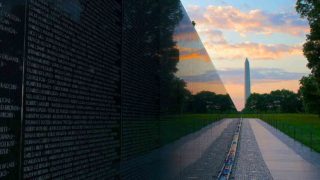

This 360° virtual campus tour of The U.S. Supreme Court requires the Adobe Flash Player.
Please enable Javascript!

Supreme Court Tour
This video tour examines the history as well as the present layout of the Supreme Court building.
Javascript must be enabled in order to access C-SPAN videos.
- Text type Text People Graphical Timeline
- Filter by Speaker All Speakers Linda McElroy
- Search this text
*This text was compiled from uncorrected Closed Captioning.

People in this video
Hosting Organization
- U.S. Supreme Court U.S. Supreme Court
Airing Details
- Oct 16, 1987 | 8:46pm EDT | C-SPAN 1
- Nov 26, 1987 | 10:26pm EST | C-SPAN 1
- Dec 21, 1987 | 3:59pm EST | C-SPAN 1
- Dec 30, 1987 | 10:15am EST | C-SPAN 1
- Feb 08, 1988 | 4:07pm EST | C-SPAN 1
- Mar 31, 1989 | 3:01am EST | C-SPAN 1
- Jun 14, 1989 | 12:50pm EDT | C-SPAN 2
- Jun 14, 1989 | 2:07pm EDT | C-SPAN 2
- Jul 21, 1989 | 3:36am EDT | C-SPAN 1
- Oct 03, 1989 | 1:00am EDT | C-SPAN 1
- Oct 19, 1989 | 5:56pm EDT | C-SPAN 1
- Nov 28, 1989 | 3:39pm EST | C-SPAN 1
- Sep 18, 1990 | 2:36am EDT | C-SPAN 1
Related Video
Senate Session
The Senate passed H.R. 2978, to amend section 700 of title 18, United States Code, to protect the physical integrity of …
The Tempting of America
Former Judge Robert Bork sat for an interview with C-SPAN’s Lew Ketcham about his book The Tempting of America: The Poli …
Supreme Court
Linda McElroy, the Supreme Court tour director conducts a visual tour of the Supreme Court Building while discussing the…
Nomination of Souter to the Supreme Court
President George H. W. Bush announced David Souter as his nominee for the position of Associate Justice of the United St…
User Created Clips from This Video
User Clip: Supreme Court Tour sample
User Clip: Court Video
User Clip: supreme court entrance
You are using an outdated browser no longer supported by Oyez. Please upgrade your browser to improve your experience.

The Secret Hoops of Justice: Inside the Supreme Court’s "Highest Court in the Land"
I n the stately halls of the Supreme Court, where the most significant legal decisions in the United States are deliberated, there lies a lesser-known chamber that sees a different kind of court action. Tucked away on the top floor of the Supreme Court Building is a basketball court that has earned the playful nickname “the highest court in the land.” While it may be overshadowed by the grandeur and solemnity of the courtrooms below, this gymnasium serves as a bastion of recreation and competition for clerks, employees, and even the justices themselves.
Constructed as part of the historic Supreme Court Building, the gymnasium was originally intended to be a storage area. However, in the late 1940s, it was transformed into a fitness space, and the precise individual responsible for converting it into a basketball court remains a mystery. It’s rumored that Cass Gilbert Jr., the son of the building’s architect and a figure who took over many of his father’s projects after his death, might have been behind the idea.
The Supreme Court Building, a National Historic Landmark, carries a weighty historical and architectural significance. Commissioned by Chief Justice William Howard Taft in 1912, who later lobbied fervently for a separate and dignified space for the judiciary, the building was completed in 1935. Architect Cass Gilbert, a friend of Taft, designed the neoclassical structure with such majesty that it was intended to reflect the “national ideal of justice in the highest sphere of activity.”
Among the stately columns and polished marble that hallmark the Supreme Court’s commitment to justice, the basketball court remains a hidden gem. A sign near the gym’s entrance warns, “Playing basketball and weightlifting are prohibited while the court is in session,” a nod to the balance of work and play for those serving the highest legal functions in the land.
Over the years, the court has seen its fair share of notable players. Justice Byron White, a runner-up for the 1937 Heisman Trophy and former National Football League player, is recognized as the Supreme Court’s premier athlete. More recently, Supreme Court Justices Elena Kagan and Brett Kavanaugh are known to have participated in games, alongside other law clerks and employees.
Relevant articles:
– The Secret Hoops of Justice: Inside the Supreme Court’s “Highest Court in the Land”
![In the stately halls of the Supreme Court, where the most significant legal decisions in the United States are deliberated, there lies a lesser-known chamber that sees a different kind of court action. Tucked away on the top floor of the Supreme Court Building is a basketball court that has earned the playful nickname “the […] In the stately halls of the Supreme Court, where the most significant legal decisions in the United States are deliberated, there lies a lesser-known chamber that sees a different kind of court action. Tucked away on the top floor of the Supreme Court Building is a basketball court that has earned the playful nickname “the […]](https://img-s-msn-com.akamaized.net/tenant/amp/entityid/BB1kKvhF.img?w=768&h=396&m=6)

- Vibe Campaign

Supreme Court Building Tours Supreme Court Building Tours Supreme Court Building Tours Supreme Court Building Tours
Opened in 1910, the historical court two features two magnificent murals “Allegory of Education” and “Fundamental Orders (1638-1639)." 45-minute presentation on the duties and obligation of the court, its history and the architecture of the building are available. Tours are available for all members of the public. Call for reservations.
Tour time: 45 minutes
Other amenities: Dining Nearby
Other Amenities
- ADA Compliant
- Groups welcome
- Indoor Activity
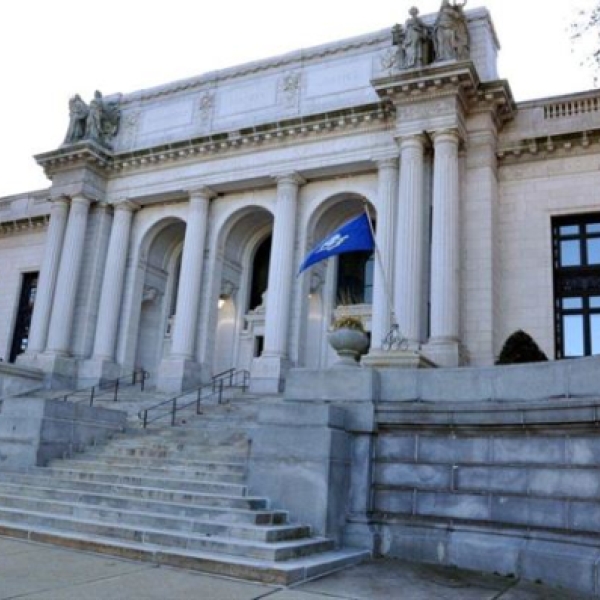
231 Capitol Ave. Hartford , CT 06106 United States
Map & Directions
visit website
While You're in the Neighborhood

Travel planning assistance 888-CTvisit (288-4748)
Connecticut Office of Tourism
450 Columbus Blvd., Suite 5 Hartford, CT 06103
- Resources & Links
- Privacy Policy
- Disclaimers
© 2024 Connecticut Office of Tourism
- Media/Press
- Email Sign Up
- Partner Login

WEEKEND RUNDOWN: Here's the biggest news you missed this weekend
Former Justice Stephen Breyer plans return to the bench as visiting judge on appeals court
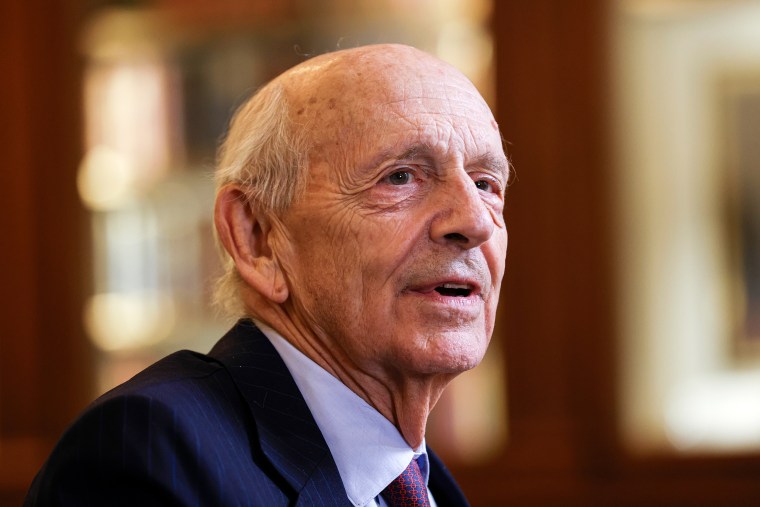
Former Supreme Court Justice Stephen Breyer is aiming to get back on the bench, this time as a visiting judge on a federal appeals court.
Breyer, who retired from the high court in 2022, said on a podcast this week that he's looking at a potential start date in the fall with the First Circuit Court of Appeals in Boston.
"I'm a judge. If you take senior status, you remain a judge, and not only you remain a judge in terms of status, but probably next fall I will go over and sit with the First Circuit," he said on the Thursday release of "Politics War Room" with journalist Al Hunt and Democratic strategist James Carville. "So I'm still an active judge."
In an email Friday, an official with the appeals court confirmed Breyer's plans.
"Justice Breyer has expressed interest in sitting with the First Circuit Court of Appeals and the Court is thrilled to have him," Circuit Executive Susan Goldberg said. "Precise dates have not been set yet."
The court encompasses the districts of Maine, Massachusetts, New Hampshire, Rhode Island and Puerto Rico.
Breyer, 85, would not be the first former justice to hear cases after leaving the Supreme Court.
David Souter , who retired from the high court in 2009, has served as a visiting judge on the First Circuit, while the late Sandra Day O'Connor , who retired in 2006, was a visiting judge with the Court of Appeals for the Ninth Circuit.
Breyer, a liberal justice, served more than 27 years on the high court. He was nominated by President Bill Clinton in 1994.
After retiring, President Joe Biden nominated Justice Ketanji Brown Jackson to succeed him. Breyer recently authored a new book titled, "Reading the Constitution: Why I Chose Pragmatism, Not Textualism."
In a March interview on NBC News' "Meet the Press," Breyer talked about one of the biggest rulings by the Supreme Court, which came at the end of his tenure as a justice. He called the leak of the court's draft decision in the Dobbs abortion case "unfortunate," while a dding that that he would be "amazed" if the source of the leak was one of the justices.
Breyer also said in the interview that it was possible Dobbs could be overturned. He was one of the three justices who dissented in the Dobbs case, which led to Roe v. Wade being overturned.
Megan Lebowitz is a politics reporter for NBC News.
- Election 2024
- Entertainment
- Newsletters
- Photography
- Personal Finance
- AP Investigations
- AP Buyline Personal Finance
- Press Releases
- Israel-Hamas War
- Russia-Ukraine War
- Global elections
- Asia Pacific
- Latin America
- Middle East
- Election Results
- Delegate Tracker
- AP & Elections
- March Madness
- AP Top 25 Poll
- Movie reviews
- Book reviews
- Personal finance
- Financial Markets
- Business Highlights
- Financial wellness
- Artificial Intelligence
- Social Media
Russian court shuts renowned rights group

Police officers detain a demonstrator as people gather in front of the Supreme Court of the Russian Federation, in Moscow, Russia, Tuesday, Dec. 28, 2021. Russia’s Supreme Court has ruled that one of the country’s oldest and most prominent human rights organizations should be shut down. The move is the latest step in a months-long crackdown on dissent. The Prosecutor General’s Office last month petitioned the Supreme Court to revoke the legal status of Memorial — an international human rights group that rose to prominence for its studies of political repression in the Soviet Union. (AP Photo)
Police officers unlock a man who chained himself to a pole in front of the Supreme Court of the Russian Federation in Moscow, Russia, Tuesday, Dec. 28, 2021. Russia’s Supreme Court has ruled that one of the country’s oldest and most prominent human rights organizations should be shut down. The move is the latest step in a months-long crackdown on dissent. The Prosecutor General’s Office last month petitioned the Supreme Court to revoke the legal status of Memorial — an international human rights group that rose to prominence for its studies of political repression in the Soviet Union. (AP Photo)
Supporters of the Memorial human rights group wearing face masks with the words “The Memorial cannot be banned!” gather in front of the Supreme Court of the Russian Federation in Moscow, Russia, Tuesday, Dec. 28, 2021. The Supreme Court is continuing hearings on the liquidation of the Memorial human rights group. The authorities are ramping up pressure on the Soviet-rooted group, as part of its months-long crackdown on activists, independent media and opposition supporters. (AP Photo/Pavel Golovkin)
Russian opposition leader Alexei Navalny is seen in a video link from a prison during a court session in Petushki, Vladimir region, about 120 kilometers (75 miles) east of Moscow, Russia, Tuesday, Dec. 28, 2021. Jailed Russian opposition leader Alexey Navalny appears in the Petushinsky court via video link at a hearing on his lawsuit against his prison colony classifying him as posing a potential extremist or terrorist threat. (Evgeny Feldman/Meduza via AP)
Russian opposition leader Alexei Navalny is seen in a video link from a prison, during a court session in Petushki, Vladimir region, about 120 kilometers (75 miles) east of Moscow, Russia, Tuesday, Dec. 28, 2021. Jailed Russian opposition leader Alexey Navalny appears in the Petushinsky court via video link at a hearing on his lawsuit against his prison colony classifying him as posing a potential extremist or terrorist threat. (Evgeny Feldman/Meduza via AP)
Russian opposition leader Alexei Navalny smiles speaking in a video link from a prison during a court session in Petushki, Vladimir region, about 120 kilometers (75 miles) east of Moscow, Russia, Tuesday, Dec. 28, 2021. Jailed Russian opposition leader Alexey Navalny appears in the Petushinsky court via video link at a hearing on his lawsuit against his prison colony classifying him as posing a potential extremist or terrorist threat. (Evgeny Feldman/Meduza via AP)
Russian opposition leader Alexei Navalny gestures while speaking via a video link from a prison during a court session in Petushki, Vladimir region, about 120 kilometers (75 miles) east of Moscow, Russia, Tuesday, Dec. 28, 2021. Jailed Russian opposition leader Alexey Navalny appears in the Petushinsky court via video link at a hearing on his lawsuit against his prison colony classifying him as posing a potential extremist or terrorist threat. (Evgeny Feldman/Meduza via AP)
- Copy Link copied
MOSCOW (AP) — Russia’s highest court on Tuesday shut down one of the country’s oldest and most prominent human rights organizations, the latest move in a relentless crackdown on rights activists, independent media and opposition supporters.
The Supreme Court’s ruling to close Memorial, an international human rights group that drew international acclaim for its studies of political repression in the Soviet Union, sparked international outrage.
Memorial is made up of more than 50 smaller groups in Russia and abroad. It was declared a “foreign agent” in 2016 — a label that implies additional government scrutiny and carries strong pejorative connotations that can discredit the targeted organization. Prosecutors said the group repeatedly failed to identify itself as a foreign agent and tried to conceal the designation, the accusations rejected by Memorial.
During the hearing, prosecutors also charged that Memorial “creates a false image of the USSR as a terrorist state,” a claim the group said revealed the authorities’ real motive.
“The Supreme Court’s ruling confirmed once again that the history of political terror organized and directed by the government isn’t an academic issue that is interesting only for experts, but an acute problem of today,” Memorial said in a statement. “Memorial embodies the Russian citizens’ need to know the truth about the country’s tragic path and the fate of millions. No one would be able to ‘liquidate’ that need.”
The group said it would appeal the verdict and pledged to continue its work.
“Of course, nothing is over with this,” Maria Eismont, one of the lawyers that represented the group in court, said after the ruling. “We will appeal, and Memorial will live on with the people — because it’s the people behind it serving this great cause first and foremost. The work will continue.”
A crowd that gathered in front of the courthouse on Tuesday erupted into chants of “Disgrace!” in response to the ruling. Police detained several people who picketed the courthouse.
The Council of Europe’s Secretary General, Marija Pejčinović Burić, described the move as “devastating news” and “a dark day for civil society in the Russian Federation.”
Amnesty International called Memorial’s closure “a blatant attack on civil society that seeks to blur the national memory of state repression” and “a grave insult to victims of the Russian Gulag.”
U.S. Ambassador John Sullivan deplored the court’s verdict as “a blatant and tragic attempt to suppress freedom of expression and erase history.”
French Foreign Minister Jean-Yves Le Drian expressed “indignation and concern” at the shutdown of the NGO Memorial International, calling it “a terrible loss for the Russian people.”
“This announcement is deeply worrying about the future of historical research and the defense of human rights in Russia,” he said in a statement.
Memorial’s sister organization, the Memorial Human Rights Center, is up for closure as well, with a court hearing Wednesday morning in Moscow City Court.
Russian authorities in recent months have ratcheted up pressure on rights groups, media outlets and individual journalists, naming dozens as foreign agents. Some were outlawed as “undesirable” and several were forced to shut down or disband themselves to prevent further prosecution.
On Saturday, authorities blocked the website of OVD-Info — a prominent legal aid group that focuses on political arrests — and urged social media platforms to take down its accounts after a court ruled that the website contained materials that “justify actions of extremist and terrorist groups.” The group rejected the charges as politically driven.
OVD-Info condemned the ruling to shut down Memorial.
“Memorial is an institution of national memory about the times of the Great Terror and Soviet repressions,” the group said in a statement, adding that its closure amounted to an attempt to justify Soviet dictator Josef Stalin’s repressions.” “It is a clear signal both to society and to the elites: ‘Yes, repressions were necessary and useful to the Soviet state in the past, and we need them today as well.’”
On Tuesday, five associates of imprisoned opposition leader Alexei Navalny were taken into custody. Earlier this year, a Moscow court outlawed Navalny’s organizations — the Foundation for Fighting Corruption and his country-wide network of regional offices — as extremist, exposing their staff members and supporters to prosecution.
One of the five detained activists, Ksenia Fadeyeva, is reportedly facing charges of forming an extremist group. Fadeyeva used to run Navalny’s regional office in the Siberian city of Tomsk, and in last year’s election won a seat in the city legislature.
Another Navalny associate, Lilia Chanysheva, was arrested and jailed in November on similar charges. She used to head Navalny’s office in the Russian region of Bashkortostan and is facing up to 10 years in prison, if convicted.
Navalny himself is serving 2½ years in prison for violating the terms of his probation from a 2014 embezzlement conviction that is widely seen as politically motivated. The politician was arrested in January upon returning from Germany, where he spent five months recovering from a nerve agent poisoning that he said was carried out by the FSB security agency on Kremlin orders — accusations that Russian officials reject.
On Tuesday, Navalny attended a court hearing on his appeal against prison authorities’ decision to put him under special surveillance as a person inclined to “extremist and terrorist” activities.
“Why should I sleep under the sign where it is written that I’m a terrorist?” he told the judge by videoconference from prison. “I didn’t explode anybody, I didn’t take hostages, I didn’t do anything like that and don’t plan to. It’s me who was a victim of a terrorist attack when FSB officers tried to kill me.”
Most of Navalny’s top associates have faced prosecution this year on various criminal charges and have left Russia.
Also on Tuesday, another prominent human rights organization — the Civic Assistance Committee that helps refugees and migrants in Russia — said the authorities were evicting it from an office in Moscow it had been allowed to occupy free of charge for years.
Moscow city officials handed the group a document voiding the agreement allowing the use of the space without compensation and ordered it to leave within a month.
“I link it to the overall trend of destroying civil society in Russia,” Civic Assistance Committee head Svetlana Gannushkina told Mediazona.
Vladimir Isachenkov in Moscow and Sylvie Corbet in Paris contributed to this report.
Russia shuts Memorial Human Rights Centre in 'one-two punch'
- Memorial Human Rights Centre kept list of political prisoners
- Centre found to have broken "foreign agent" law
- Affiliated Memorial centre already shut on Tuesday
- Critics say move is latest attack on dissent
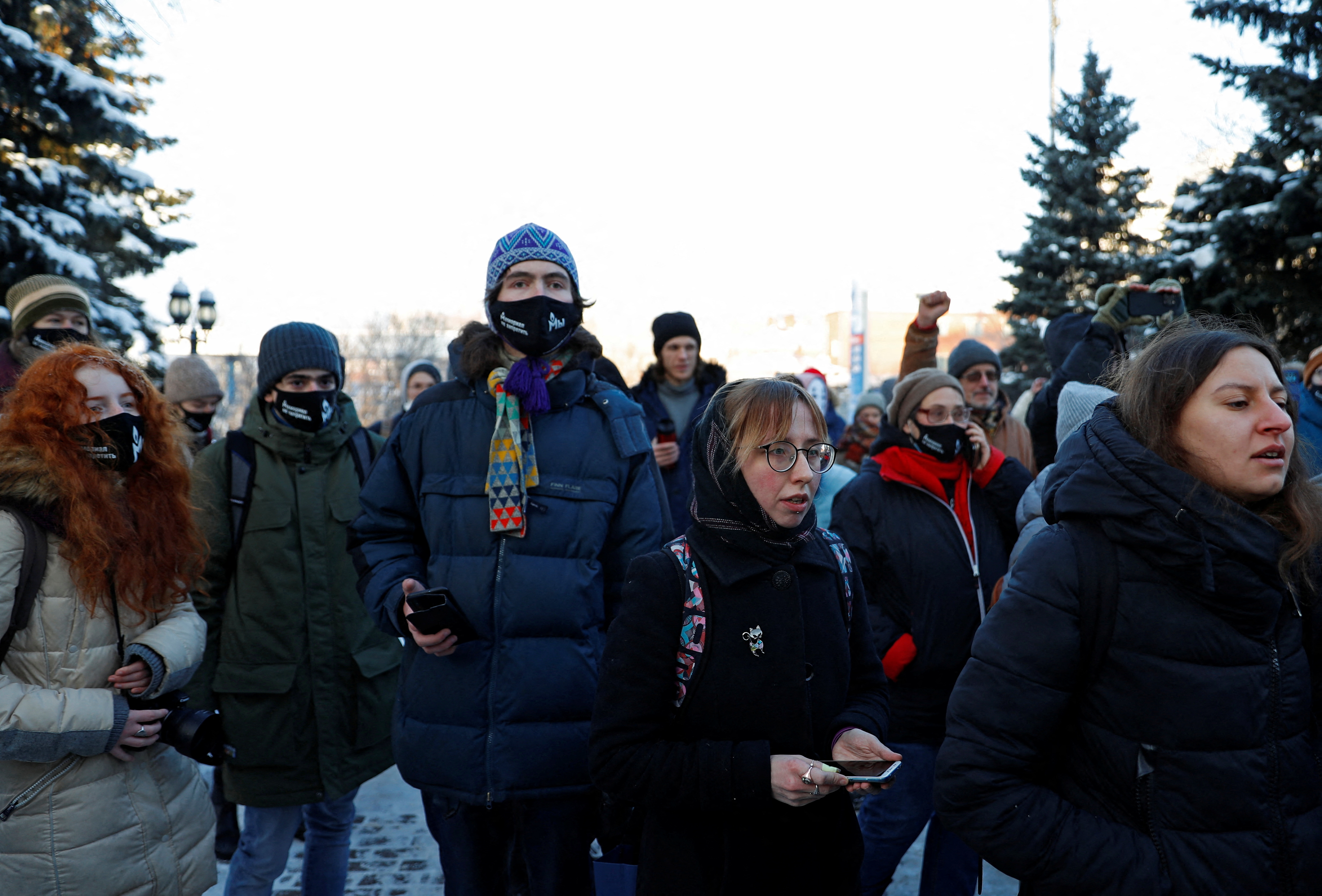
'TOO AWKWARD'
The Reuters Daily Briefing newsletter provides all the news you need to start your day. Sign up here.
Additional reporting by Svetlana Ivanova and Maxim Rodionov in Moscow, by Olzhas Auyezov and by Stephanie Nebehay in Geneva; Editing by Kevin Liffey and Barbara Lewis
Our Standards: The Thomson Reuters Trust Principles. , opens new tab

Thomson Reuters
As Russia Chief Political Correspondent, and former Moscow bureau chief, Andrew helps lead coverage of the world's largest country, whose political, economic and social transformation under President Vladimir Putin he has reported on for much of the last two decades, along with its growing confrontation with the West and wars in Georgia and Ukraine. Andrew was part of a Wall Street Journal reporting team short-listed for a Pulitzer Prize for international reporting. He has also reported from Moscow for two British newspapers, The Telegraph and The Independent.

Airline passengers in parts of the United Kingdom and Ireland faced travel disruption at airports on Saturday due to flight cancellations as a storm swept across both countries and left thousands of Irish homes with power outages.

Record flood waters rise in Russia's Urals, forcing thousands to evacuate
A string of Russian regions in the Ural Mountains and Siberia, alongside parts of neighboring Kazakhstan have been hit in recent days by some of the worst floods in decades.
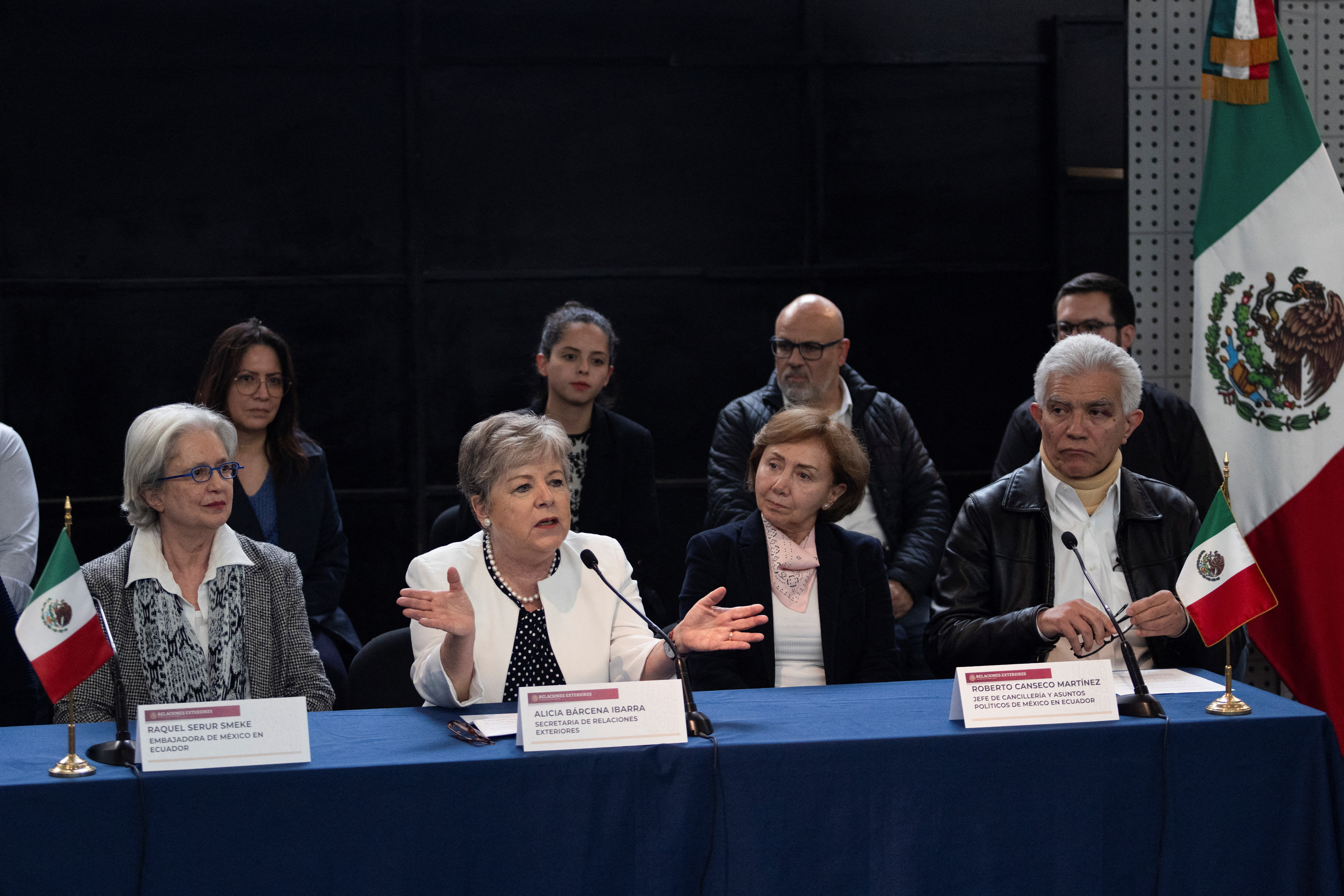

IMAGES
COMMENTS
The Supreme Court of the United States is located on First Street NE between East Capitol Street and Maryland Avenue, adjacent to the U.S. Capitol and the Library of Congress. ... 96, 97, and A11 buses all stop in front of the Supreme Court Building. The 32, 34, 36, and 39 buses stop at First Street and Independence Avenue, a two block walk ...
Self-Guides. Use the following guides to enhance an on-site visit or learn about the Supreme Court Building from home. See Architectural Information for more detailed descriptions of the building's architectural features and highlights. Look closely and take in the East and West Pediments, the Fraser statues flanking the front steps, the ...
The Supreme Court Building is located at 1 First Street St NE across the street from the US Capitol Building and the Library of Congress. Use this link for directions to the Supreme Court . Or let us take you here on one of our pay-what-you-like Capitol Hill Tours. It is a 7 min walk from the Capitol South Station Metro ( Blue, Orange, Silver ).
6 Stop 6 open 9am-4:30 pm. Free. Share: Email Print. Upon arrival at the Supreme Court, visitors are often struck by the imposing marble building. Architecturally magnificent, the neoclassical structure was built in 1935 to become the permanent home to the Supreme Court. Walking along the hallway towards the Courtroom, guests are greeted by ...
Take a virtual tour of United States Supreme Court. This 360° Virtual Tour gives you a detailed panoramic look at the historic courtroom, judges' chambers, conference rooms, libraries and halls.
First occupied on October 7, 1935, the Supreme Court building is a fitting home for the nation's third branch of government. Chief Justice William Howard Taft was behind the effort to provide the Court with its own building, moving out of the U.S. Capitol where it had been meeting since 1801. The Court did not move far, however.
The Supreme Court Building houses the Supreme Court of the United States, the highest court in the federal judiciary of the United States.The building serves as the official workplace of the chief justice of the United States and the eight associate justices of the Supreme Court.It is located at 1 First Street in Northeast Washington, D.C. It is one block immediately east of the United States ...
The U.S. Supreme Court building in Washington, D.C. houses the U.S. Supreme Court, the highest court in the land. It's the official residence and workplace o...
This video tour examines the history as well as the present layout of the Supreme Court building. Report Video Issue Go to Live Event Javascript must be enabled in order to access C-SPAN videos.
A multimedia judicial archive of the Supreme Court of the United States. Oyez. About; License; Lawyer Directory; Projects. Shifting Scales; Body Politic; Advocates; Top Advocates Report; Site Feedback; ... Take a virtual tour of United States Supreme Court. This 360° Virtual Tour gives you a detailed panoramic look at the historic courtroom ...
The Supreme Court Building is open to visitors Monday through Friday from 9:00 AM to 4:30 PM (excluding federal holidays). Visitors are encouraged to take advantage of a variety of educational programs available during their visit, including courtroom lectures, a visitors' film, and exhibitions that are changed periodically.
The Supreme Court Building, a National Historic Landmark, carries a weighty historical and architectural significance. Commissioned by Chief Justice William Howard Taft in 1912, who later lobbied ...
The Supreme Court building is open from 9:00 a.m. to 4:30 p.m., Monday through Friday. Tours, including a lecture in the Courtroom, are typically given every hour on the half-hour on days that the Court is not sitting, beginning at 9:30 a.m. and concluding at 3:30 p.m. A film and other exhibits on the Supreme Court are located on the ground floor.
Contact. (860) 757-2270. visit website. Opened in 1910, the historical court two features two magnificent murals "Allegory of Education" and "Fundamental Orders (1638-1639)." 45-minute presentation on the duties and obligation of the court, its history and the architecture of the building are available. Tours are available for all members ...
David Souter, who retired from the high court in 2009, has served as a visiting judge on the First Circuit, while the late Sandra Day O'Connor, who retired in 2006, was a visiting judge with the ...
Tours can be scheduled Monday - Thursday (no Friday, Saturday or Sunday tours) Only one tour group can be scheduled per day. If you are interested in bringing a class to tour the Supreme Court Building in Salem or to hear oral arguments there, view the calendar below for tour availability. Then request a tour to arrange a visit. Request a ...
The Supreme Court of the Russian Federation (Russian: Верховный суд Российской Федерации, romanized: Verkhovny sud Rossiyskoy Federatsii) is a court within the judiciary of Russia and the court of last resort in Russian administrative law, civil law and criminal law cases. It also supervises the work of lower courts. Its predecessor is the Supreme Court of the ...
Russian court shuts renowned rights group. Police officers detain a demonstrator as people gather in front of the Supreme Court of the Russian Federation, in Moscow, Russia, Tuesday, Dec. 28, 2021. Russia's Supreme Court has ruled that one of the country's oldest and most prominent human rights organizations should be shut down.
[1/7] Supporters of the human rights group Memorial gather outside the Moscow City Court building during a hearing to consider the closure of the Memorial human rights center in Moscow, Russia ...